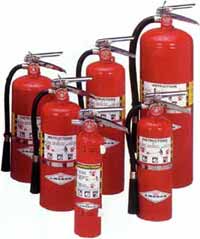 |
|
|---|---|
| Fire Extinguisher Ratings | |
| Types of Fire Extinguishers | |
| Fire Extinguishers Common Features | |
| Rules for Fighting Fires | |
| How to Use a Fire Extinguisher | |
| Safety tips for Fire Extinguishers |
 |
|
|---|---|
| Fire Extinguisher Ratings | |
| Types of Fire Extinguishers | |
| Fire Extinguishers Common Features | |
| Rules for Fighting Fires | |
| How to Use a Fire Extinguisher | |
| Safety tips for Fire Extinguishers |
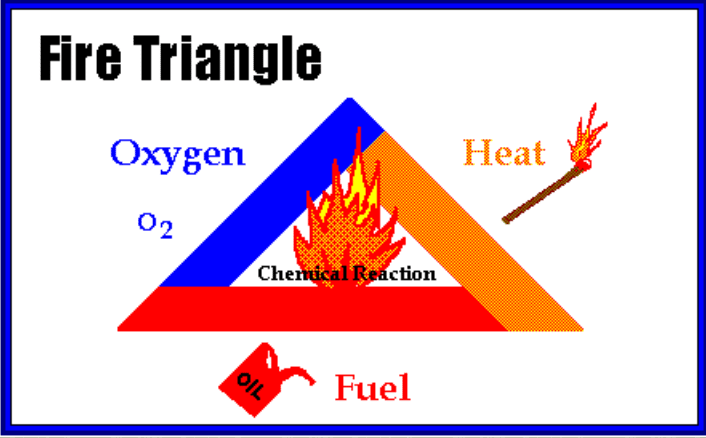
| Fire Safety, at its most basic, is based upon the principle of keeping fuel sources and ignition sources separate. |
|---|
| Three components must be present at the same time to produce fire: |
| 1. Enough OXYGEN to sustain combustion |
| 2. Enough HEAT to reach ignition temperature |
| 3. Some FUEL or combustible material |
| Then a CHEMICAL REACTION will develop to produce a fire |
Remove any one of the three components to extinguish the fire. |
The fire triangle or combustion triangle is a simple model, from the science of firefighting, for understanding the ingredients necessary for most fires. It has largely been replaced in the industry by the fire tetrahedron, which provides a more complete model, also described below. |
![]()
![]()
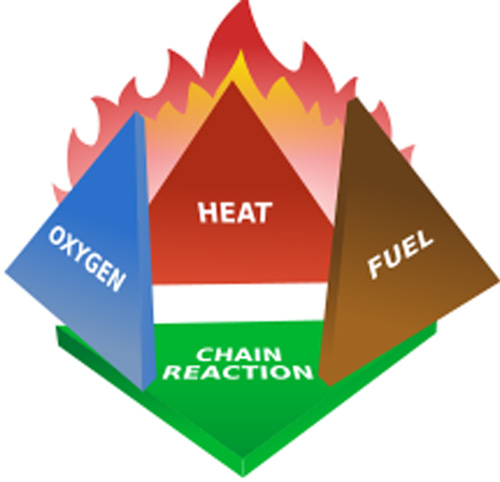
| The fire triangle is a useful teaching tool, but fails to identify the fourth essential element of fire: the sustaining chemical reaction. This has led to development of the fire tetrahedron: a triangular pyramid having four sides (including the bottom). Some fire suppression agents do not remove or reduce any of the three necessary components, but rather interfere with their chemical combination, such as Halon. In most fires, it does not matter which element gets removed; the fire fails to ignite, or it goes out. However, there are certain chemical fires where knowing only the “fire triangle” is not good enough. |
| Combustion is the chemical reaction that feeds a fire more heat and allows it to continue. With most types of fires, the old fire triangle model works well enough, but when the fire involves burning metals (known as a class-D fire in the American system of fire classifications, involving metals like lithium, magnesium, etc.), it becomes useful to consider the chemistry of combustion. Putting water on such a fire could result in the fire getting hotter (or even exploding) because such metals can react with water in an exothermic reaction to produce flammable hydrogen gas. Therefore, other specialized chemicals must typically be used to break the chain reaction of metallic combustion and stop the fire. |
![]()
![]()
| Fires are classified according to the type of fuel that is burning. |
| If you use the wrong type of fire extinguisher on the wrong class of fire, you might make matters worse. |
| Its very important to understand the five different fire (fuel) classifications… |
| New labeling system. | Old labeling system. | Class A and Class B fire extinguishers have a numerical rating which is based on tests conducted by Underwriter's Laboratories that are designed to determine the extinguishing potential for each size and type of extinguisher. |
 |
Class A Extinguishers will put out fires in ordinary combustibles, such as wood, paper, cloth and plastics. The numerical rating for this class of fire extinguisher refers to the amount of water the fire extinguisher holds and the amount of fire it will extinguish. |  |
 |
Class B Extinguishers should be used on fires involving flammable liquids, such as grease, gasoline, oil, etc. The numerical rating for this class of fire extinguisher states the approximate number of square feet of a flammable liquid fire that a non-expert person can expect to extinguish. |  |
 |
Class C Extinguishers are suitable for use on electrically energized fires. This class of fire extinguishers does not have a numerical rating. The presence of the letter “C” indicates that the extinguishing agent is non-conductive. |  |
| Class D Extinguishers must match the type of metal that is burning. Such extinguishers have a label with a list detailing the metals that match the dry powder in the extinguisher. There is no picture designator for Class D extinguishers. These extinguishers generally have no rating nor are they given a multi-purpose rating for use on other types of fires. |  | |
| Class K Extinguishers are designed for kitchen fires. In the United States, the designation "Class K" was recently assigned to these cooking media fires. This new classification is recognized by the National Fire Protection Association (NFPA) Standard for the Installation of Portable Fire Extinguishers, NFPA 10, and the UL Standard for the Rating and Fire Testing of Fire Extinguishers, ANSI/UL 711. |
 |
Many extinguishers available today can be used on different types of fires and will be labeled with more than one designator, e.g. B-C, or A-B-C. Make sure that if you have a multi-purpose extinguisher it is properly labeled. |
| This is the old style of labeling indicating suitability for use on Class A, B, and C fires. |  |
 |
This is the new labeling style with a diagonal red line drawn through the picture to indicate what type of fire this extinguisher is NOT suitable for. In this example, the fire extinguisher could be used on Ordinary Combustibles and Flammable Liquids fires, but not for Electrical Equipment fires. |
![]()
![]()
 |
Water fire extinguishers (A) The most common agent is water; however, it cannot be used for class B or C fires because it is conductive. Water-based fire extinguishers are usually used in stockrooms, schools, offices, etc. They are filled about two-thirds of the way with ordinary water, then pressurized with air. In some cases, detergents are added to the water to produce a foam. They stand about two to three feet tall and weigh approximately 25 pounds when full. |
 |
Carbon Dioxide (CO2) fire extinguishers (B, C) Carbon dioxide removes oxygen to stop a fire but has limited range. It is environmentally friendly and leaves no residue, so cleanup is unnecessary. The carbon dioxide is stored as a compressed liquid in the extinguisher. As it expands, it cools the surrounding air. The cooling will often cause ice to form around the “horn” where the gas is expelled from the extinguisher. Since the fire could re-ignite, continue to apply the agent even after the fire appears to be out. Extinguishers with carbon dioxide are usually used in contamination-sensitive places such as computer rooms, labs, food storage areas, processing plants, etc. |
 |
Dry Chemical fire extinguishers Multi-Purpose Dry Chemical (A, B, C) A dry chemical agent called mono ammonium phosphate. The chemical is non-conductive and can be mildly corrosive if moisture is present. In order to avoid corrosion, it is necessary to scrub and thoroughly clean up the contacted area once the fire is out. A dry chemical fire extinguisher is usually used in schools, general offices, hospitals, homes, etc. Regular Dry Chemical (B, C) A dry chemical agent called sodium bicarbonate. It is non-toxic, non-conductive and non-corrosive. It is easy to cleanup, requiring only vacuuming, sweeping or flushing with water. Extinguishers with sodium bicarbonate are usually used in residential kitchens, laboratories, garages, etc. Purple K Dry Chemical (B, C) A dry chemical called potassium bicarbonate. It is non-conductive and non-corrosive. Cleanup requires vacuuming, sweeping or flushing with water. Extinguishers with potassium bicarbonate are usually used in military facilities, oil companies, vehicles, etc. |
 |
Foam fire extinguishers (A, B) Foam floats on flammable liquids to tame the fire and helps prevent reflashes. To clean up the affected area, it must be washed away and left to evaporate. Fire extinguishers with foam are usually used in garages, homes, vehicles, workshops, etc. |
 |
Halotron fire extinguishers (A, B, C) A vaporizing liquid that is ozone friendly and leaves no residue. Because it requires no cleanup, fire extinguishers with halotron are ideal for computer rooms, telecommunication areas, theaters, etc. |
 |
Kitchen fire extinguishers These fire extinguishers are typically required in a commercial kitchen setting for fires involving combustible cooking fluids such as oils and fats. |
 |
Cartridge Operated fire extinguishers Typically used in high hazard areas where fast and assured fire protection are needed. Examples include mining operations, utilities and forestry. |
 |
Automatic/Manual system fire extinguishers These systems are for chemical/flammable storage areas, electrical rooms, film storage rooms and other normally unoccupied areas. They typically use either carbon dioxide or nitrogen expellant gas. |
 |
Wheeled Fire Extinguish Where quick mobility is a must. Applications include petroleum plants, airports, large storage facilities, construction sites and equipment depots. These extinguishers replicate most wall and vehicle mounted systems and are available for all Fire Classes. Being highly mobile and containing a larger volume of extinguishing agent makes these units highly desirable where quick response to potentially large fire hazards may exist. |
![]()
![]()
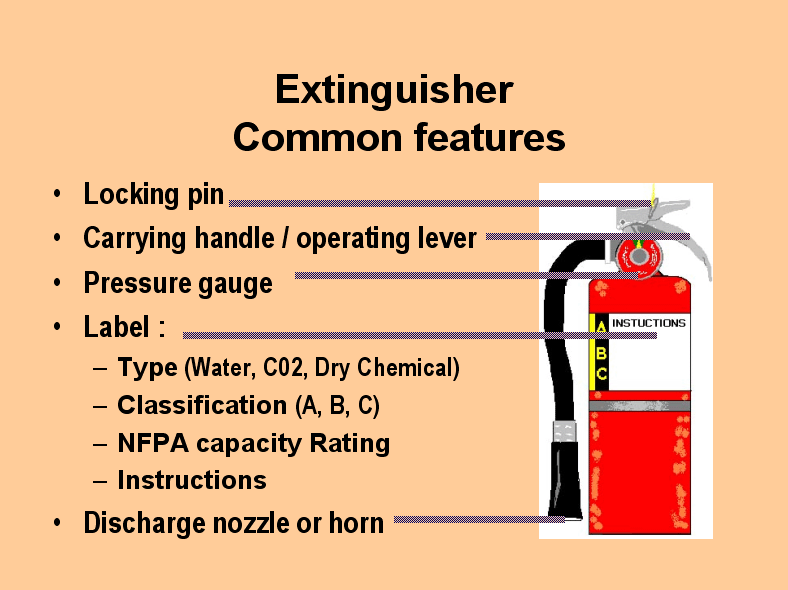 |
|---|
![]()
![]()
Upon discovery of fire or smoke |
|---|
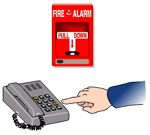 |
Activate the building alarm system or notify the fire department by calling 911. Or have someone else do this for you. |
|---|---|
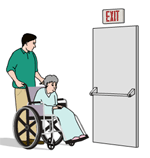 |
Assist any persons in immediate danger, or those incapable of exiting the building on their own. |
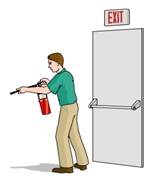 |
Only after the above two are completed should you Attempt to extinguish the fire. |
![]()
![]()
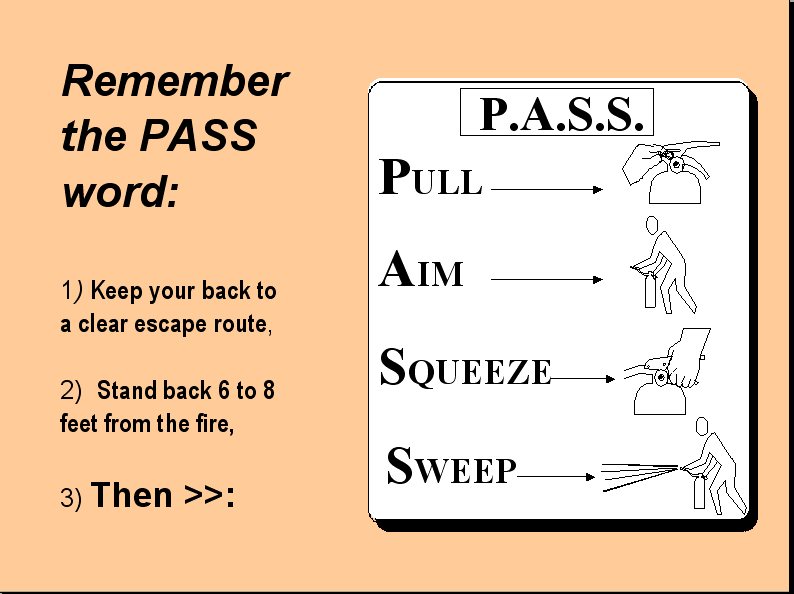 |
|---|
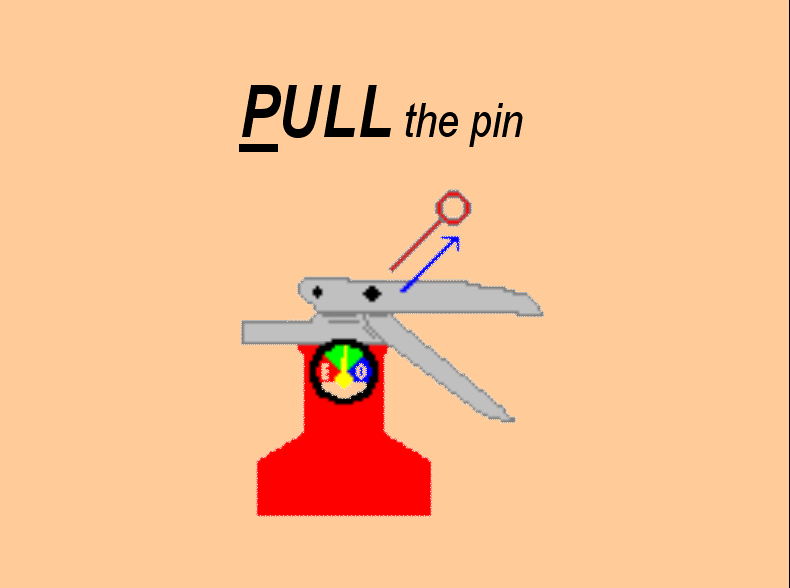 |
|---|
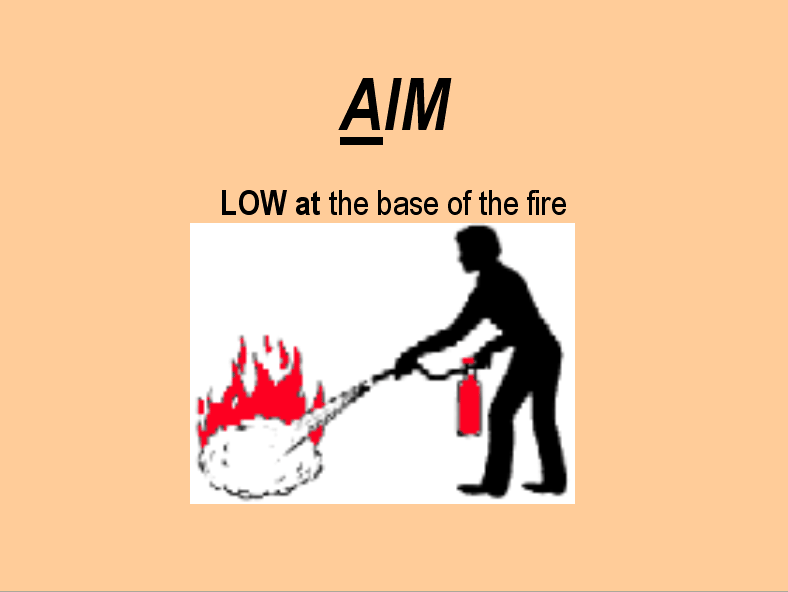 |
|---|
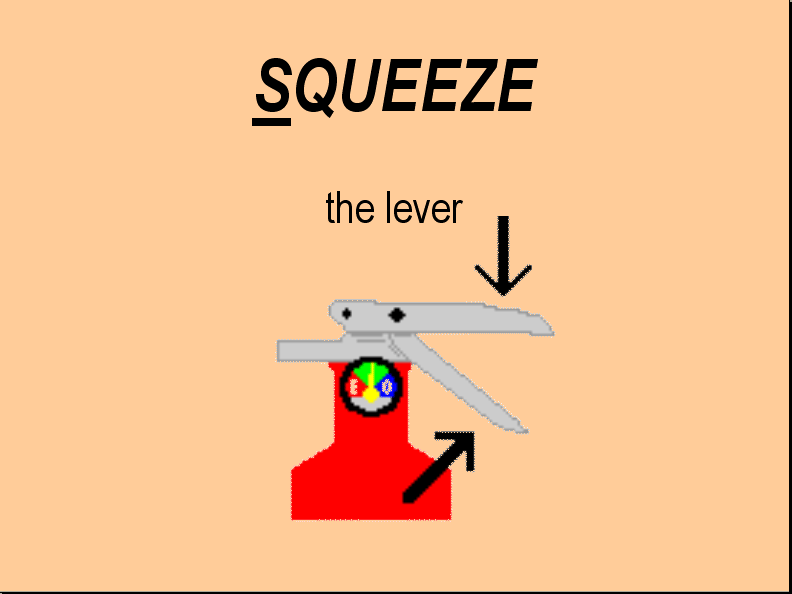 |
|---|
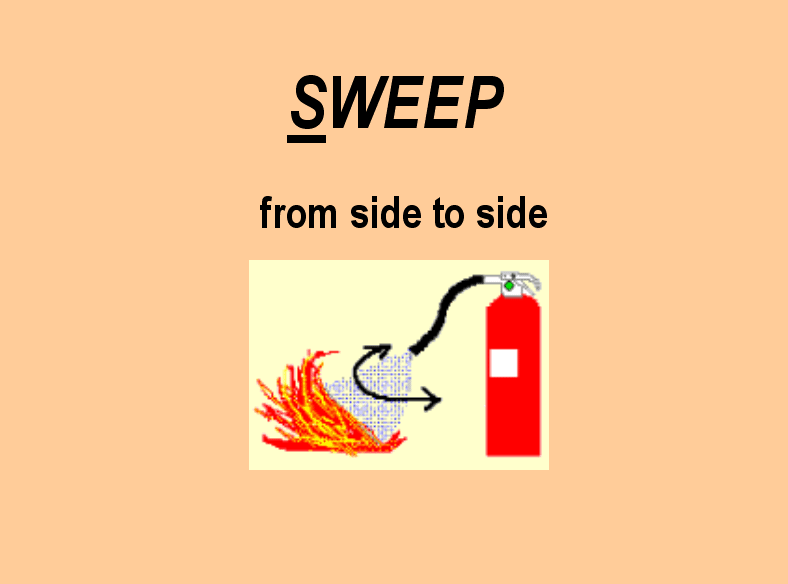 |
|---|
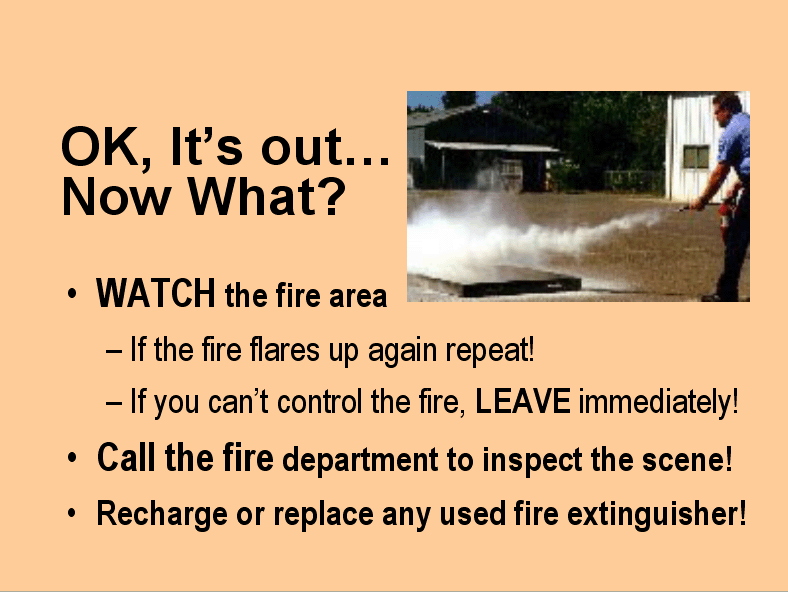 |
|---|
| A typical fire extinguisher contains 10 seconds of extinguishing power. This could be less if it has already been partially discharged. Always read the instructions that come with the fire extinguisher beforehand and become familiar with its parts. It is highly recommended by fire prevention experts that you get hands-on training before operating a fire extinguisher. Most local fire departments offer this service. |
| Once the fire is out, don't walk away! Watch the area for a few minutes in case it re-ignites. Recharge or replace the extinguisher immediately after use. |
![]()
![]()
A portable fire extinguisher can save lives and property by putting out a small fire or containing it until the fire department arrives; but portable extinguishers have limitations. Because fire grows and spreads so rapidly, the number one priority for residents is to get out safely.
|
![]()
![]()
 |
|---|
![]()
![]()
Return to Fire Extinguisher Information and Training
![]()
 |
 |
 |
 |
 To Kolb |
|---|